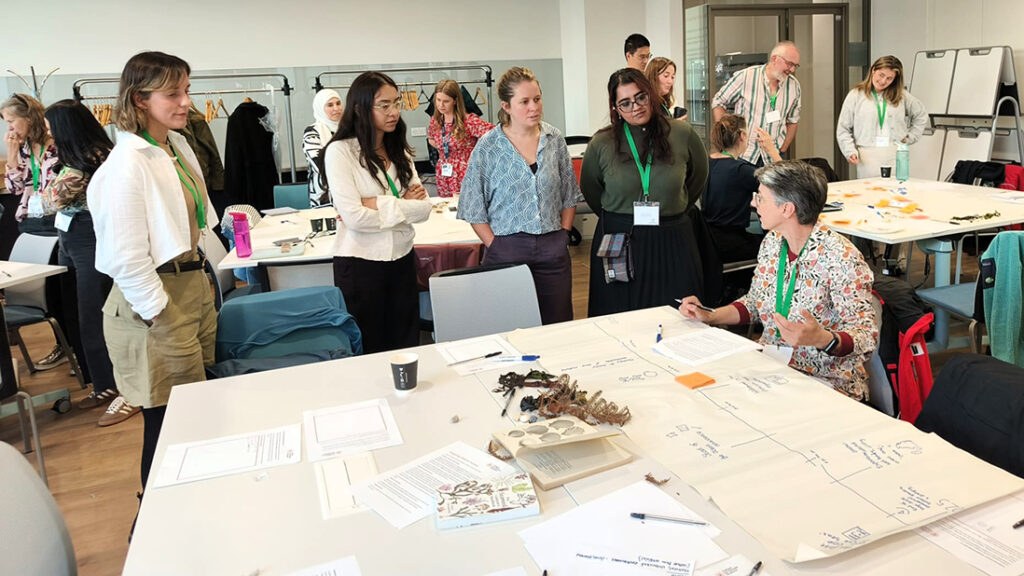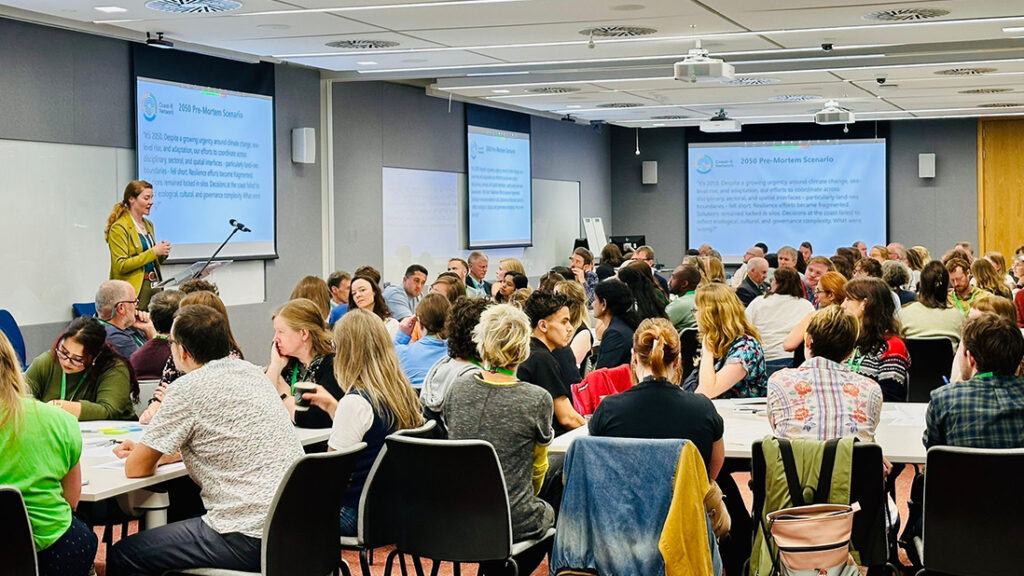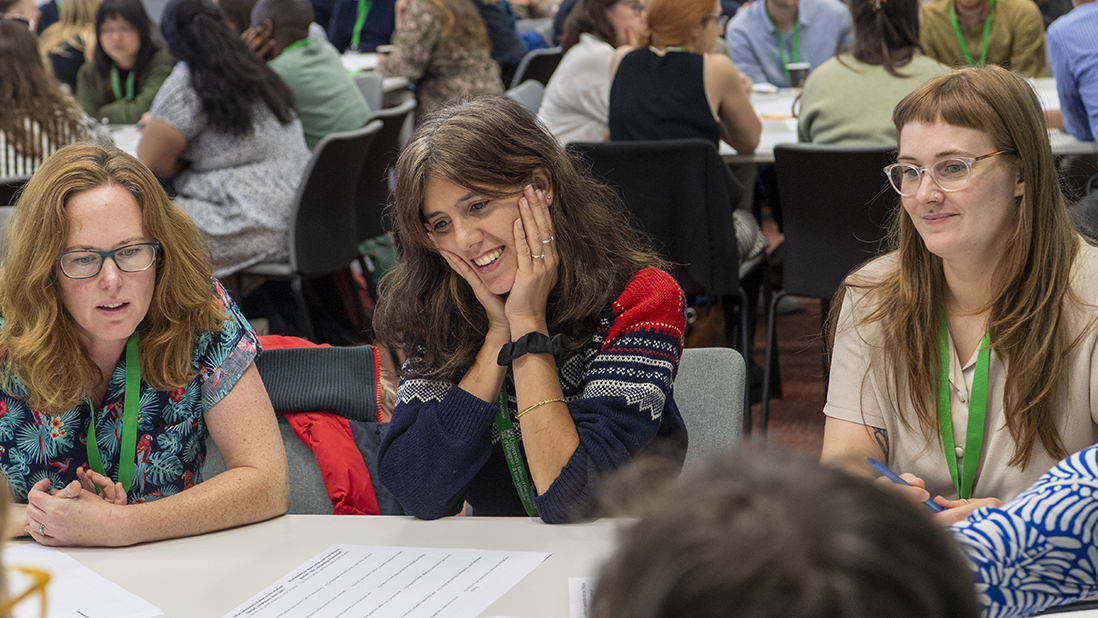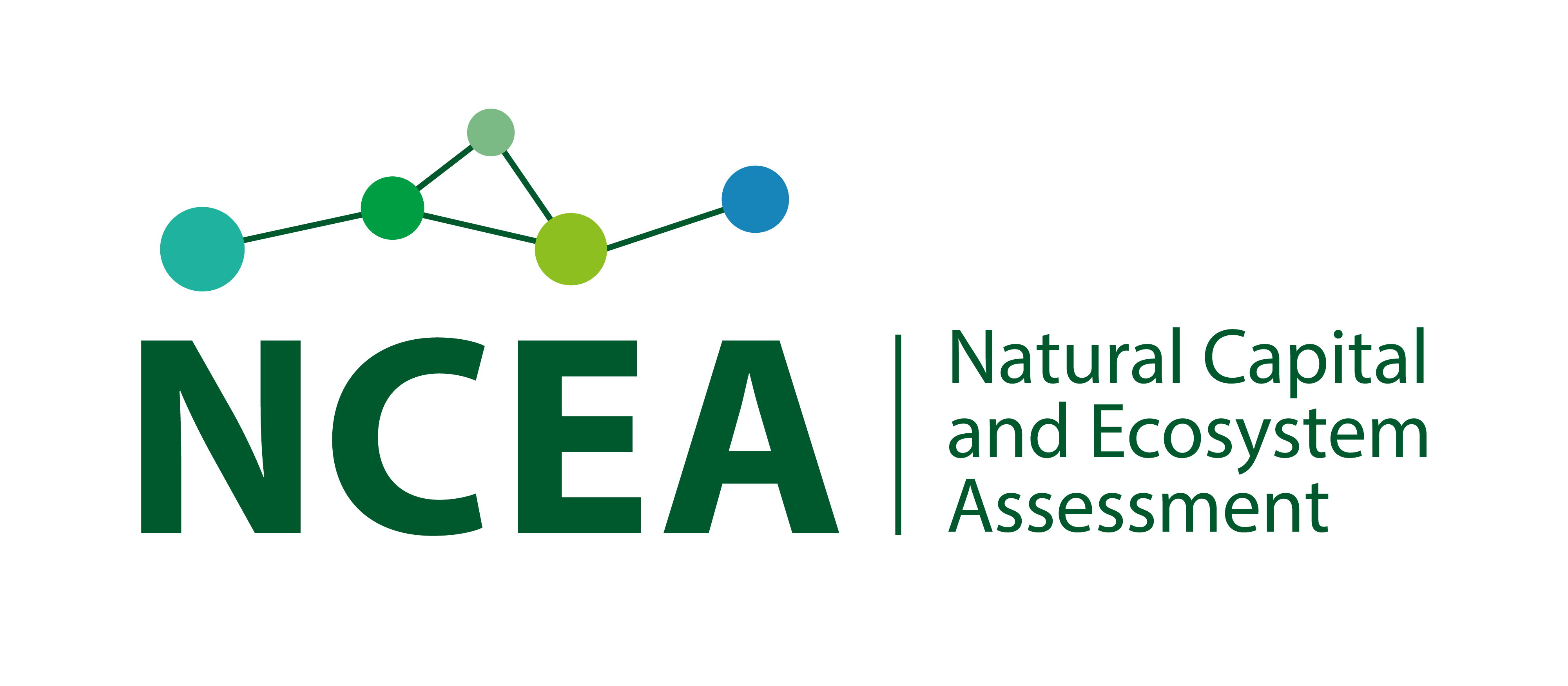Dr Katherine Simpson of the University of Glasgow and Lewis Coenen-Rowe of Culture for Climate Scotland reflect on two interactive workshops from our recent Annual Forum and look towards next steps.
In early September, as part of the Coast-R Network Annual Conference in Glasgow, we brought together around 120 people from across disciplines, sectors, and communities for two workshops designed to explore a vital question: how do we rethink the interfaces that shape our coastal futures?
Hosted under the banner Back from the Brink – Rethinking Interfaces for Coastal Resilience, the sessions invited participants to step into the future, reflect on what might go wrong, and then co-create pathways towards better outcomes. With climate pressures intensifying and decisions about coasts and seas becoming ever more complex, the workshops aimed to uncover risks and enablers of collaboration across land–sea boundaries, disciplines, and sectors.
Workshop One: A Pre-Mortem of 2050
The first workshop, led by Katherine Simpson, asked participants to imagine themselves in 2050 — but in a world where efforts to build coastal resilience had failed. Why start with failure? Because a pre-mortem flips the familiar idea of a post-mortem on its head. Instead of asking what went wrong after the fact, it invites us to imagine failure before it happens – and then work backward. This approach helps surface risks that optimism bias often hides, brings diverse perspectives to the fore, and ultimately unlocks more robust solutions. As Katherine framed it:
“Different people see different kinds of failure – what looks like success in one sector can look like exclusion in another. A pre-mortem makes space for that.”
The 2050 scenario that set the stage wasn’t comfortable: despite urgency around climate change, sea-level rise, and adaptation, efforts to coordinate across land–sea boundaries and disciplines had fallen short. Resilience was fragmented, locked in silos, and unable to reflect ecological, cultural, and governance complexity. From this starting point, participants worked in groups to ask:
- What went wrong between land and sea?
- Where did coordination fail across research, policy, and practice?
- How did communication break down?
- What misaligned systems or unclear responsibilities contributed to the collapse?
From there, groups turned to the STEEPLE framework — a structured tool that helps unpack the many forces shaping coastal resilience across seven domains: Social, Technological, Economic, Environmental, Political, Legal, and Ethical. At first glance, the framework looks straightforward, but in practice it opened up some of the most dynamic conversations of the day. Each table filled with sticky notes as participants explored what had gone wrong and what was already working well. It ensured that no dimension was left in the blind spot, while making visible the connections across them. As one participant noted:
“Seeing the barriers and enablers side by side really helped us see where the levers for change might be — and that solutions aren’t only technical or financial, they’re also social and ethical.”
Key Findings from the Pre-Mortem
When groups came back together for the share-back session, strong common themes emerged across the discussions. Despite tackling the future from different angles, participants repeatedly highlighted the same challenges and opportunities:
- Governance and coordination: Many called for clearer roles and responsibilities across land–sea boundaries and between sectors. Without this, coordination falters and resilience efforts become fragmented.
- Funding and timescales: A recurring frustration was the way political cycles undermine long-term resilience planning. As one participant put it, “We need to decouple funding from political timescales.”
- Communities at the centre: Several groups stressed that adaptation efforts must begin with people, not be imposed on them. “Start with communities” became a rallying phrase, tied to both trust and cultural capital.
- Education and engagement: Participants saw proactive education as a vital enabler — helping communities understand risks, navigate change, and shape solutions together.
- Data and decision-making: While data was seen as essential, its granularity and format often fail to match the needs of practitioners and communities. Better interoperability and accessibility were repeatedly called for.
- Despite the hard truths, participants also articulated hopeful visions. One group imagined “an adapting community who are engaged in adaptation measures and planning, with politics and resourcing for equitable changes.” Another ended on a simple but powerful note: “People are happy.”
Taken together, the share-back underscored that resilience is not only about technical fixes or policy levers. It is about time – making space to learn from the past while planning for the long term. It is about equity — ensuring that adaptation supports, rather than sidelines, communities. And it is about imagination – building futures where adaptation is not only possible, but desirable.
Workshop Two: Imagining Radical Futures

The second workshop, co-facilitated by Culture for Climate Scotland staff Lewis Coenen-Rowe and Eleanor White and artists Eve Mosher and Jennifer Argo, flipped the perspective. Instead of starting with failure, participants were invited to imagine radically positive futures for our coasts, focusing on their senses and how it would feel for them personally.
Why take this approach? Because imagining the future through our senses can help us move beyond immediate challenges and technical fixes. It personalises climate adaptation, and makes space for creativity, empathy, and new forms of communication. As the facilitators explained, “This is about seeing beyond practicalities and connecting to how a resilient future might feel, sound, or even taste. By anchoring visions in sensory experience, we open up different kinds of knowledge and imagination.”
The session began with an individual exercise: each participant pictured a coastal place they knew well in 2050, where climate change was being mitigated and adapted to fairly and effectively. Each person focused on one of the five senses – sight, sound, touch, smell, or taste – to describe their vision. This prompt encouraged lateral thinking and helped draw out aspects of resilience that are often overlooked, from the smell of clean sea air to the bright green fronds of restored kelp forests.
Next, groups combined their individual reflections into shared visions of coastal futures. From there, participants worked backwards, constructing timelines from the future. Using large sheets of paper and creative materials, they charted the key turning points, decisions, and collaborations that could lead to their ideal 2050. Groups added “artefacts” — imagined news headlines, sketches, charts, or representative objects — to bring their stories of change to life. The result looked like a set of museum exhibits from the future, each telling the history of how resilience was achieved. One memorable contribution was a mock newspaper headline declaring “Scotland’s first midge-free summer, 2035.” It drew laughter but also sparked reflection: while fewer midges might feel like a small victory, the headline also pointed to a dramatically altered climate on Scotland’s west coast — warmer, drier, and fundamentally changed. This juxtaposition captured the spirit of the exercise: playful, imaginative, but rooted in the serious realities of climate adaptation.
The workshop closed with participants exploring each other’s timelines and noticed patterns across the different visions. The aim was not to produce a single blueprint but to stretch the imagination of what’s possible, and to map out the kinds of collaborations and choices that could make it real.
Certain themes did emerge consistently between different groups, many of which emphasised deeper participation, collaborative decision-making, movement building and tackling systemic inequities as key to bringing about change. More darkly, many of the groups imagined a disaster in the near future being needed to provoke the actions that would lead to their positive vision. Did this demonstrate a failure of our collective imagination to see a way out of existing cycles without relying on an external force? Tensions also emerged between some visions that emphasised a heightened engagement between humans and coastal habitats, while others imagined a reduced human influence and a process of rewilding. Overall, positive future visions tended to coalesce around themes of balance, coming to terms with inevitable changes, and slowness or ease. However, as one participant noted, the timeline exercise also highlighted that “2050 is only a blink of an eye away”.
Shared Insights and Next Steps
Across both workshops, what stood out was the power of bringing diverse perspectives together. From government agencies to educators, from creative practitioners to industry representatives, participants highlighted that resilience depends on working across boundaries — disciplinary, sectoral, and geographic.
Both the pre-mortem and the radical futures exercises reinforced the need for clarity in roles, better alignment of policies and funding, and stronger communication channels. At the same time, the imaginative methods surfaced fresh ways of thinking about justice, equity, and the lived experience of coastal change.
The energy in the room was palpable: creative, challenging, and deeply engaged with the urgency of coastal resilience. The insights gathered will inform a forthcoming Solutions Report, drawing together the key risks, enablers, and recommendations generated through the workshops.
Why This Matters
Coastal resilience is not just a technical or ecological issue. It is about people, cultures, economies, and ecosystems intertwined across land and sea. By rehearsing both the failures we must avoid and the futures we aspire to, these workshops offered a space for radical rethinking and practical planning.
As one participant reflected:
“We don’t often get the chance to step outside our silos and imagine together. This felt like building the history of a future we still have time to create.”















